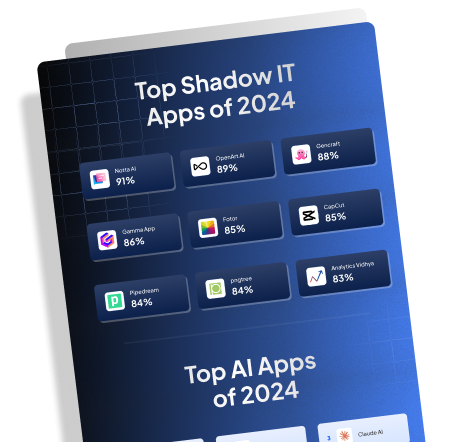What is IT Governance?
IT Governance is the framework that aligns an organization’s information technology strategy with its business objectives. It provides a structure for decision-making and accountability, emphasizing efficiency, risk management, and compliance. Effective IT Governance ensures the optimal use of technology resources to meet business goals.
The SaaS Management Connection
In the era of Software as a Service (SaaS), IT Governance becomes even more crucial. A robust governance structure is required to manage numerous SaaS applications and ensure they align with the organization’s strategic objectives. SaaS Management Platforms can facilitate this alignment by offering centralized control over software assets, usage metrics, and compliance data. Learn more about Torii’s complete SaaS Management Platform, empowering modern IT with visibility and control.
Examples of IT Governance
While some might simply associate information technology governance with the word “no”—as in, “can I download this application?”—IT governance is actually a wide set of strategies that ensure an organization is effective in their technology usage.
Real-Life Example: In a financial institution, a governance board oversees IT projects to ensure they align with organizational goals and compliance standards. The governance process involves risk assessments, stakeholder engagement, and a rigorous review by the Chief Information Officer (CIO). When a new SaaS tool is considered for customer service management, the governance framework ensures it fits into the existing enterprise architecture and complies with data protection regulations.
IT Governance Best Practices
For organizations seeking to optimize their IT strategies, following IT Governance best practices is crucial. A well-defined governance framework can serve as a roadmap for strategic alignment between IT and business objectives, facilitating informed decision-making and stakeholder engagement.
Strategic Alignment: Ensure that IT initiatives align with organizational goals and business strategy. Create a governance board that includes senior executives and key stakeholders for periodic reviews.
Risk Management: Continuously assess IT-related risks. From data breaches to project failures, comprehensive risk assessments help prioritize resources and actions.
Compliance and Regulations: Stay up-to-date on local, national, and international regulations that could impact your IT structure. Regular audits and reviews are necessary for maintaining compliance.
Resource Optimization: Maximize the utility of both human and technological resources. Implement tools and frameworks that allow for efficient asset management, including SaaS applications.
Performance Metrics: Establish Key Performance Indicators (KPIs) to measure the effectiveness of IT governance. Metrics could include system uptime, project completion rates, and user satisfaction scores.
Stakeholder Communication: Create open channels for stakeholder feedback and communication. Transparency builds trust and ensures alignment with business objectives.
Adaptability: The technology landscape is ever-changing. A good governance framework should be flexible enough to adapt to new technologies, methodologies, and business requirements.
By adhering to these best practices, organizations can achieve effective governance, resulting in operational excellence, reduced risks, and a higher return on IT investments.
Related Terms You Should Understand
IT Management: The day-to-day administration and maintenance of IT resources.
Corporate Governance: The broader system of rules and practices by which a corporation is directed and controlled.
IT Project Management: The planning and execution of IT projects, often involving software development and infrastructure upgrades.
Framework: A basic structure underlying a system or concept, in this case, IT Governance.
Stakeholders: Individuals or groups who are impacted by or have an interest in the organization’s IT decisions.
Compliance: Adherence to laws, regulations, and organizational policies.
IT Risk Management: The identification and mitigation of IT-related risks that could negatively impact the organization.
By understanding these related terms, you’ll gain a comprehensive grasp of how IT Governance functions within an organization, especially in the context of SaaS management.
IT governance is the structure, framework, and strategy to ensure that an organization’s IT infrastructure is safe, efficient, and effective as it works towards its mission.
Often a combination of procedures, rules, and processes, IT governance provides a framework for how an organization utilizes technology to achieve their mission.
Once formulated and introduced to an organization, IT governance establishes how to use software, hardware, and other IT-related assets—now and in the future.
What are the four 4 focus areas of IT governance?
While not always just these four areas, IT governance typically focuses on these four areas for effective management:
- Strategic Alignment with Business: Ensure that the governance framework and procedures implemented for technology work to empower, rather than hinder, business operations.
- Value Delivery: Ensure that technology implementation provides ROI and perform continued procedures such as application rationalization to optimize ROI of technology investment.
- Risk Management: Ensure that IT risk is considered, mitigated, and accounted for in the case of failure.
- Resource Management: Ensure company resources are easily accessible for stakeholders, backed up in the case of failure, and maintained in a state of confidential readiness.
How can you create an IT governance structure?
Creating a successful and productive IT governance structure involves four important steps:
- Understand the basics and structure of how your organization uses technology
- Prioritize business objectives and understand how IT governance can contribute to those objectives
- Design and implement processes and systems that help achieve actionable progress towards greater business success
- Communicate with relevant stakeholders to gauge the success of relevant processes, breed adoption, and adjust accordingly
One easy win when activating IT governance is getting a handle on SaaS management. For enterprise organizations, SaaS management can quickly enable cost savings, security improvements, and greater efficiency.
